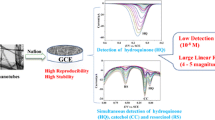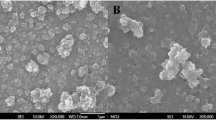Abstract
Glassy carbon electrodes (GCE) modified with carbon nanotubes (CNT) have been created for detection of phenolic compounds—one of the important group of antioxidants in life sciences. The surface of electrode has been characterized by atomic force microscopy. The presence of CNT leads to an at least 20-fold increase in the surface roughness of the electrode. The CNT layer displays closely intertwined vermicular structures with high degree of homogeneity at CNT suspension concentration of 0.2–0.5 mg L−1. Synthetic water-soluble antioxidants (hydroquinone, catechol, pyrogallol, and their derivatives) are electrochemically active on bare GCE and CNT-modified GCE in phosphate buffer solution pH 7.4. Effect of substitutes in molecular structure of phenolic antioxidants has been evaluated. In several cases, oxidation at CNT-modified GCE occurs at potentials that are less positive by 100–200 mV in comparison to bare GCE. The electrodes were studied with respect to their capability of phenols voltammetric sensing. CNT-modified GCE display an enlarged linear range in the calibration graphs and lower detection limits. Voltammetric method for determination of hydroquinone, catechol, pyrogallol, and their derivatives has been developed.








Similar content being viewed by others
References
Pospisil J, Klemchuk PP (1989) Oxidation inhibition in organic materials, V. I. CRC Press Inc, Boca Raton
Rice-Evans CA, Miller NJ, Paganga G (1996) Free Radic Biol Med 20:933–956
Lin H, Gan T, Wu K (2009) Food Chem 113:701–704
Safavi A, Maleki N, Tajabadi F (2007) Analyst 132:54–58
de Oliveira IRWZ, Neves A, Vieira IC (2008) Sens Actuators B 129:424–430
Freire RS, Durán N, Kubota LT (2002) J Braz Chem Soc 13:456–462
Kulys J, Vidziunaite R (2003) Biosens Bioelectron 18:319–325
Roy JJ, Abraham TE, Abhijith KS, Kumar PVS, Thakur MS (2005) Biosens Bioelectron 21:206–211
Dinçkaya E, Akyilmaz E, Akgöl S, Tatar Önal S, Zihnioglu F, Telefoncu A (1998) Biosci Biotechnol Biochem 62:2098–2100
Kochana J, Nowak P, Jarosz-Wilkołazka A, Bieroń M (2008) Microchem J 89:171–174
Liu Z, Liu Y, Yang H, Yang Y, Shen G, Yu R (2005) Anal Chim Acta 533:3–9
Pérez López B, Merkoçi A (2009) Analyst 134:60–64
Tang L, Zeng G, Liu J, Xu X, Zhang Y, Shen G, Li Y, Liu C (2008) Anal Bioanal Chem 391:679–685
Adamski J, Kochana J (2008) Acta Chim Slov 55:623–626
Musameh M, Wang J, Merkoci A, Lin Y (2002) Electrochem Commun 4:743–746
Wang J (2005) Electroanalysis 17:7–14
Xue K, Xu W, Yin S (2007) J Electrochem Soc 154:F147–F151
Zhang D, Peng Y, Qi H, Gao Q, Zhang C (2009) Sens Actuators B 136:113–121
Ghanem MA (2007) Electrochem Commun 9:2501–2506
Aziz MdA, Selvaraju T, Yang H (2007) Electroanalysis 19:1543–1546
Ziyatdinova GK, Gainetdinova AA, Budnikov GK (2010) J Analyt Chem 65:929–934
Sharafutdinova EN (2007) Potentiometry in investigation of antioxidant activity of plant objects. Academic dissertation, Ekaterinburg (In Russian)
Red’kin AN, Kipin VA, Malyarevich LV (2006) Inorg Mat 42:242–245
Grazhulene SS, Red’kin AN, Telegin GF, Bazhenov AV, Fursova TN (2010) J Analyt Chem 65:682–689
Ross SD, Finkelstein M, Rudd EJ (1975) Anodic oxidation. Academic, New York
Baizer MM, Lund H (1983) Organic electrochemistry. Marcel Dekker, New York
Kilmartin PA, Hsu CF (2003) Food Chem 82:501–512
Yang B, Kotani A, Arai K, Kusu F (2001) Anal Sci 17:599–604
Yang B, Kotani A, Arai K, Kusu F (2001) Chem Pharm Bull 49:747–751
Novak I, Šeruga M, Komorsky-Lovrić Š (2009) Electroanalysis 21:1019–1025
Acknowledgments
Authors would like to thank Prof. Khiena Brainina for granting samples of synthetic phenolic antioxidants. Financial support of RFBR (grant 09-03-00309-a) is gratefully acknowledged.
Author information
Authors and Affiliations
Corresponding author
Rights and permissions
About this article
Cite this article
Ziyatdinova, G., Gainetdinova, A., Morozov, M. et al. Voltammetric detection of synthetic water-soluble phenolic antioxidants using carbon nanotube based electrodes. J Solid State Electrochem 16, 127–134 (2012). https://doi.org/10.1007/s10008-011-1295-x
Received:
Revised:
Accepted:
Published:
Issue Date:
DOI: https://doi.org/10.1007/s10008-011-1295-x




